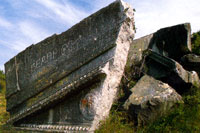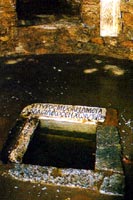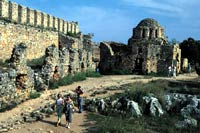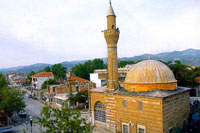Where to Visit
İznik Museum ( Nilüfer Hatun Soup Kitchen)
This structure is one the beautiful examples of 14th century Ottoman Architecture. In 1338, Ottoman Ruler Murat the first built it as an İmaret (soup kitchen) in memory of his mother Nilüfer Hatun. This charity house served meal to poor people every day. In Ottoman Architecture, T-shaped plan was used for the first time during the construction of this house. After having been used as a storehouse in the Republican Era, it was put into operation as a museum in 1960. Archaeological works of art from Roman, Byzantine and Ottoman Periods are on display in the Museum. The works, having been unearthed in İznik Tile Kilns Excavation, draw the attention of many people.
Tumulus, Rock Tombs and Monuments
 Berber Rock
Berber Rock
Berber Rock, a large room-shaped monumental tomb having been carved in rock, is located at the foot of a hill in the west of İznik. There are graves on the ground. It dates back to the 2nd century, and it is one of the important examples of the Hellenistic Period in İznik.
Beştaş
This monumental tomb, raising among vineyards in the west of the district, is on the road of ancient Rome. The tomb is also called as Obelisk or Nişantaşı. It is understood from the inscription in Greek that this tomb belonged to C. Cassius in the 1st century. An eagle or a statue of Nike, the Goddess of Victory is thought to have been over the 6th stone on the top of the tomb. It is clear from the remains that there is a statue of Philiscus in the other side of the tomb.
Hypoge
It is an underground tomb in Elbeyli Village. It is understood that it was built in the 4th or 5th century. The ceiling and walls are covered with coloured frescoes, typical to the early Christianity period. There are 3 graves in the grave room.
Dörttepeler Tumulus
It is in the graveyard within Elbeyli Municipality. Two monumental tombs are found in the Tumulus. The first tomb is nearby the road. Rectangular grave room with a dromos (narrow passageway to the grave room), has two klines (stone seating) on both sides. The other tomb is in a grave room made of marble, and covered with rough stone and trees.
Senatus Palace (Byzantium Palace)
The palace was built in the 4th century, and it is now covered with the lake water. Floor mosaics are under ground. The first Nicaea Consul which was very important for the Christian Community gathered here in 325.
 City Walls
City Walls
The pentagonal city walls surrounding İznik are 4970 metre long. The construction of the city walls started in Hellenistic Period. But they took their final shape by the new additions during the Roman and Byzantine Periods. When looked from the junction point of two streets, four main gates can be seen. Two of the four main gates, namely Lefke and Constantinople Gates, have survived to the present day in good condition. Marble relief frieze pieces were used in the construction of these two gates. The masks brought from the theatre can be seen in Constantinople Gate.
Theatre
İznik Ancient Theatre was built on a large area between the lake shore and Yenişehir Gate. Theatre was built by the efforts of Bithynia Proconsul, Plinius in between 111 and 112 during the reign of Empire Traianus. It was turned into a mass grave in the 13th century. In the following years, archaeological excavations revealed that a Church, Palace, Ottoman Ceramic Workshops and Tile Kilns had been constructed within it.
 Bocek Ayazma
Bocek Ayazma
Being one of the intact remains from the 6th century, the structure is thought to have been a part of Hyakinthos Monastery. This circular structure, having been covered with a dome, is next to the Koimesis Church.
The Church of Koimesis
Bishop Hyakinthos had it built in the 8th century. It is supposed to have been a part of Hyakinthos Monastery. It was fully demolished by the earthquake in 1065, and later on it was renovated by additions. The mosaics and icons of the Church were renovated again in 1807.
 The Church of Hagia Sophia
The Church of Hagia Sophia
Being at the junction of two streets, the Church is in the city centre. It is a work of Byzantine Period, and thought to have been renovated probably after the earthquake in 1807. It was renamed Orhan Ghazi Mosque in 1331. Having been demolished by the earthquake and fire, church was renewed to a great extent by Architect Sinan in 16th century. On the wall of a grave room, there is a fresco of Christ. The 7th Consul in 787 gathered there. Therefore, it is an important spot for faith tourism.
The Church of Hagios Tryphonos
It is located on the left side of the street towards Constantinople Gate. The cross shaped church has four columns. The wall technique and the cross-shaped plan of the church indicate that it was a Byzantine work having been built between the 10th and 12nd centuries.
The Church of Ayatrifon
Supposed to have been built by Teodoros Laskaris in the name of Aya Trinos in 13th century, the church is located on the right side of the street leading to the Yenişehir Gate. Its plan is similiar to the one used in Kariye Mosque in İstanbul. It is understood from the plan that it was covered with a huge dome, and its floor is decorated with beautiful mosaics.
Hacı Özbek Mosque
It was the first Ottoman mosque built in Iznik in 1333. Its tile-covered dome is in 8 m in diameter. The mosque does not have a minaret.
Green Mosque
Green Mosque, named after the colour of its minaret, is the symbol of the İznik. It was built by Architect Hacı Mustafa between 1378 and 1391. With its single dome, it is one of the most splendid mosques having been built in the Early Ottoman Period. Its unique minaret is on the right side of the mosque. Its unique minaret, which is a reflection of Seljuk tradition on the Ottoman art in the early period, is on the right side of the mosque. The main part is ornamented with blue and green ceramic tiles in a zigzag mosaic technique.

Mahmut Çelebi Mosque
Mahmut Çelebi it built in 1442. Its square main part is covered with a single dome. The minaret is bricky.
Orhan Bey Mosque
The ruins of the mosque is located outside of the Yenişehir Gate. There is a Turkish Bath between the mosque and the city walls.
Tombs
Sheikh Kutbettin Mosque and Tomb, Eşref-i Rumi Mosque and Tomb, Yakup Çelebi Lodge and Tomb, Kırgızlar Tomb, Sarı Saltuk Tomb, Hayrettin Pasha Tomb, Çandarlı İbrahim Pasha Tomb and Soup Kitchen, Çandarlı Halil Pasha Tomb, Huysuzlar Tomb, Ahiveyn Sultan Tomb, Abdülvahap Sancaktarı Tomb are the important tombs in İznik.
Rüstem Paşa Inn
At present, it is in ruin between the houses. Some north and east parts of its wall is standing. It was built in the 16th century.
İsmail Bey Hamam (Public Bath)
It dates back to the late 14th and the early 15th centuries. With its interior architecture, it is an outstanding structure. The bath, covered with four domes, has five sections.
Hacı Hamza Hamam (Public Bath)
The bath is located next to the Mahmut Çelebi Mosque built in the 15th century. It is also called as Murat the second Bath. There are two different sections for Women and Men, and Men Section is still being used.
Meydan Hamam (Public Bath)
The other name of the bath is Murat the first Bath. It dates back to the 14th century. The bath has two sections.